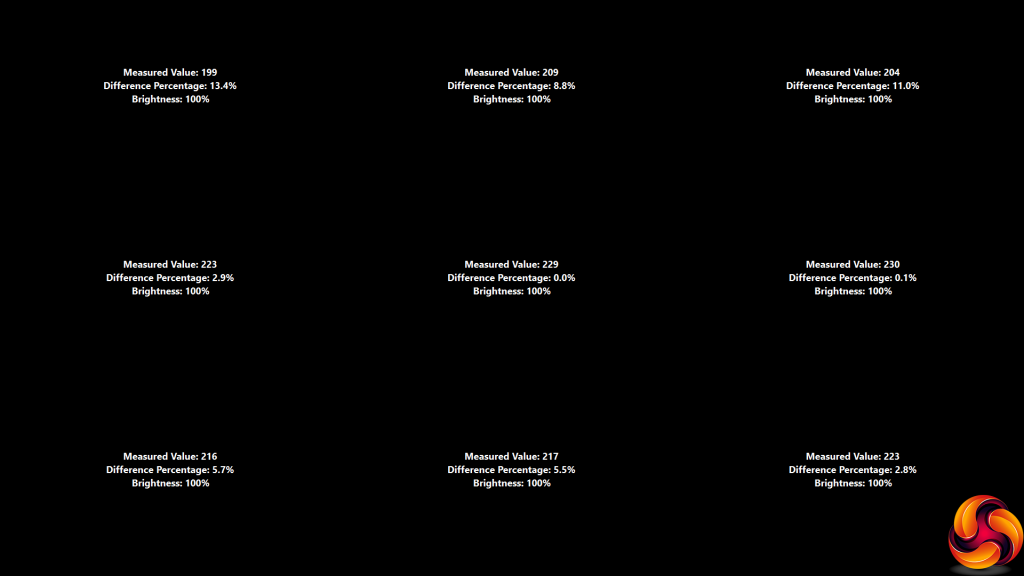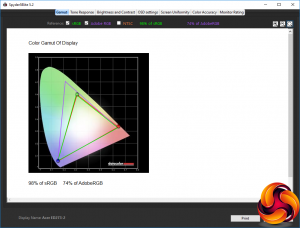Our main test involves using a DataColor Spyder Elite 5 Colorimeter to assess a display’s image quality. The device sits on top of the screen while the software generates colour tones and patterns, which it compares against predetermined values to work out how accurate the screen is.
The results show –
- A monitor’s maximum brightness in candelas or cd/m2 at various levels set in the OSD.
- A monitor’s contrast ratio at various brightness levels in the OSD.
- The brightness deviation across the panel.
- The black and white points.
- The colour accuracy, expressed as a Delta E ratio, with a result under 3 being fine for normal use, and under 2 being great for colour-accurate design work.
- The exact gamma levels, with a comparison against preset settings in the OSD.
We first run this test with the display in its default, out-of-the-box state, with all settings on default. We then calibrate the screen using the Spyder software and run the test again.
We always test the display subjectively on the Windows desktop, using it for general tasks such as browsing and word processing, and with games as well, even if the display is not intended solely for that purpose.
We pay careful attention to any artefacts, ghosting or motion blur, and enable any gaming-specific features, such as adaptive-sync settings like G-Sync or FreeSync, using a compatible graphics card in our test PC.
We performed the quality tests on the ED273 at its native 1,920 x 1,080 resolution in the default mode, after resetting the OSD, which uses a 60Hz refresh. Our test system was equipped with an AMD Radeon Vega Frontier Edition graphics card, which also supports FreeSync.
Things don't get off to a great start with the gamut. The ED273 can't even manage 100 per cent of sRGB – falling just shy at 98 per cent – and only achieves 74 per cent of AdobeRGB, which is also a rather lowly score.
The story doesn't improve that much when it comes to brightness uniformity, with a lot of aberration along the top edge of the screen, and particularly in the top corners.
Colour uniformity, however, is much more impressive, with very little variation across the screen at any point or brightness level.
Although the extremely high contrast specification, which is with dynamic contrast enabled, isn't borne out in the real world, contrast is still very good at all brightness levels. We have come to expect good contrast from VA panels. This is not a very bright monitor, however, only achieving 229.1cd/m2 even at 100 per cent. This is below the 250cd/m2 spec. The white point is fairly consistent, sticking at 7300K at 50 per cent brightness and above. It doesn't dip too far below that at lower levels, either.
There really isn't a lot of variation between the OSD presets. You can see that the Normal and Game options are the same, because Game is actually the default mode after a reset. The PC mode has a lower brightness and slightly higher 7400K white point, while Movie mode actually achieves close to the specified 250cd/m2 brightness, with the highest 1,700:1 contrast. The black level is also marginally higher. But there really isn't much to differentiate these options other than the brightness levels.
There are no gamma options on this monitor, but the default settings equate closely to 2.0. This is lower than most screens, which usually rest around 2.2.
So far, this screen hasn't particularly excelled in the quality department, but the colour accuracy score isn't that bad. With an average variance of 2.14, it's not up with the very best, but punches above its price, which is definitely to be commended.
However, is it possible to squeeze a little more out of this screen with calibration? We used the Spyder's facilities to see if we could improve performance.
No change to the gamut, which remains as poor as it was before.
The gamma is identical, too, with a fairly solid 2.0 value.
The good news is that colour accuracy is now an impressive 0.98 average variance, although there are some large variations with specific hues. You usually only see this level with premium screens.
Overall, the ED273 is a very mixed bag. The colour accuracy is decent, and excellent when calibrated. The colour uniformity is also very good. But in most other areas this is a very average screen, and lack of OSD features rather limits your options too.
We tried the screen out in everyday tasks, including a few games, and while the curviness aided immersion a little, the gaming experience in particular was average. But we have been rather spoilt by high refresh screens with adaptive synchronisation in the last couple of years, so going back to a screen without this will always seem less responsive.
 KitGuru KitGuru.net – Tech News | Hardware News | Hardware Reviews | IOS | Mobile | Gaming | Graphics Cards
KitGuru KitGuru.net – Tech News | Hardware News | Hardware Reviews | IOS | Mobile | Gaming | Graphics Cards















